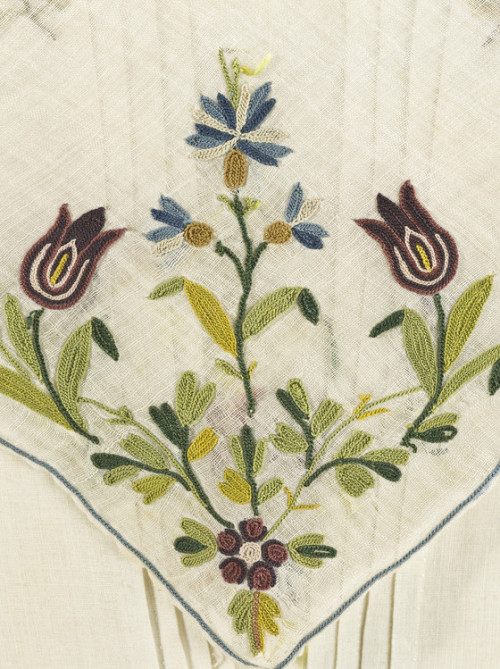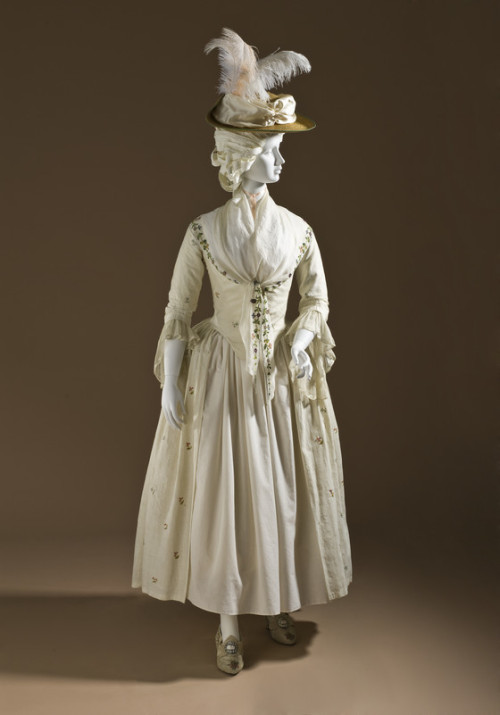#georgian fashion
For the longest time now I’ve been stuck in a creative block, so much so that my semester break passed without me even planning a sewing project. But a couple of days ago I was browsing the webs for some fabric because I wanted to redo my robe à la française when I stumbled upon some perfect silk taffeta for a time period I’ve never tackled before - so, needless to say, since I got a great deal on the fabric I decided to jump head first into an 1830s project.

I’m not sure what this dress is going to look like, I’m not even 100% set on which half of the decade I want to do. On the one hand, when I first started historical costuming, I was really fascinated by the early 1830s silhouette, but when I got familiar with the later styles I also really fell in love with those smocked/gathered sleeves that are more 1837-38ish. Here they are once again in comparison:


Personally, I think I like the late style slightly better, but at the same time I feel like I’m betraying the 1830s by not going for the more iconic and well known look with the huge sleeves.
I really like this dress for example even though it’s a little lowkey for the time.

At the same time I’m also obsessed with this one. I even had a dream once that I got this exact fabric to recreate it.

Also, it seems like silk was more popular earlier in the decade. There is also the possibility of making two bodices, one for day and one for evening wear. I think I’ll have to think about it and actually do some proper research in the next couple of days. But yeah, I think this whole project is going to take a while as I have to make all the undergarments as well and have no experience whatsoever in this era. I hope the construction is similar to 18th century gowns, that way it won’t be that difficult. I also have to make this happen in between uni classes, so please bear with me! I’ll probably document the entire mock-up process so I’ll have something to write about in the meantime. If you’ve made anything from this era before and/or have any tips and tricks, please let me know!
White Wedding Dresses Throughout History
The rumor that Queen Victoria started the “white wedding dress trend” is so widely spread that many people don’t question it, but while it is somewhat true, it’s not the full truth and here’s why.
It is true that after Queen Victoria’s marriage in 1840, the white wedding dress gained popularity up until in the late 19th century, when it became a standard color for wedding gowns. However, white wedding dresses already existed prior to that.
I’m starting this wedding dress history in the 18th century, when a wedding was less about love and romance and more about politics, so a wedding was the perfect opportunity for the bride to showcase her status, and since white fabrics were generally more expensive and rarer than other colors, it was a popular choice. However, that doesn’t mean that other vibrant colors and/or prints weren’t just as popular back then, if not even more.
But since I’m focusing on white dresses in this post and I will make a separate post on non-white wedding dresses soon, here are two examples of an 18th century wedding dress.
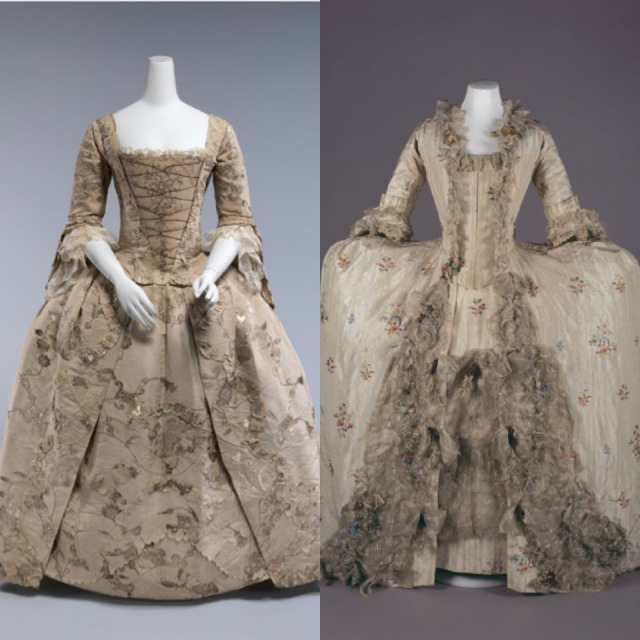
The first one from 1747 is a Robe à l’Anglaise, the second one from 1775 a Française. As you can see, they both have trimmings and decorations and that is because the focus wasn’t on making the dress white as it is today, it was more about showcasing what you were able to afford, so intricate trimmings and embroidery were the way to go. People would also continue to wear their wedding dresses for other special occasions, it wasn’t really an exclusive garment that you’d only wear once. Maybe the super affluent ones could actually afford to do that, but it was way more common than not to wear one’s wedding dress to other events, as the wedding dress wasn’t really a separate type of dress but rather just a more expensive version of a formal dress.
The early 19th century brought light muslin dresses, so a lot of special occasion dresses were already white. In the later regency decades, these muslin wedding dresses were more intricately decorated with embroidery for example, as shown in these beautiful extent pieces from 1807 and ca. 1830.

I couldn’t possibly make this post without including Queen Victoria’s wedding dress.


I read that the reason the white dress was such a big deal was because she was expected to wear the crimson velvet robe of the state. Instead, she announced that on her wedding day she would focus on being Albert’s future wife rather than the monarch and chose to wear a white dress as a symbol of innocence and romance. But either way, the monarchs were the fashion icons of that time, so it’s no wonder those who could afford it started to wear similar things to the queen.
Moving on to the next decade, here is a lovely muslin wedding dress from 1851.

It’s a very down to earth dress, not very flashy and it’s interesting to note the gathered/smocked front as it’s something that was very popular during the 1840s and very early 50s.
From the 60s, we have this pretty light beige dress, and yes I know I said white dresses only but none of them are perfectly white so I think I’ll let it pass.

Notice how all of the dresses so far strictly follow the fashion trends of that time? I think it’s really interesting if you compared it to today because it would essentially be the equivalent of just wearing a white version of a semi-formal outfit, which isn’t really a thing and shouldn’t be in my opinion. I’m all for wear what you want but I feel like we’ve already lost the charme of beautiful fancy outfits and I’m glad we still have the traditional white gown for weddings at least. If you’re already wearing fancy gowns on a daily basis, obviously the only thing you can do to make it stand out is make it white (or any other uncommon color for that matter). I would also like to mention that when I came up with the idea to write about wedding gowns I was expecting them to be white versions of evening/ball gowns but they’re mostly just day dresses. Very surprising I think.
For the 1870s I have two examples, since one is strictly speaking not white and they’re both really lovely and worth a mention.

You can totally see the completely different styles and approaches even though they were made within two years from each other. I also really adore the leaf trimmings and the sheer (-looking?) fabric. What I don’t love though is the robe-like front, it looks a little too casual for my taste.
Let’s move on to the 80s with this gown.

Now, that’s what I call a wedding dress! It’s not too casual, it’s most definitely fancy and those pearl accents- It really reminds me of Worth’s work with pearls (I am seriously contemplating making a post just showing pictures of Worth gowns with pearl decoration cause those are my absolute favorite thing) but it was actually made by Messrs Gladman and Womack in 1885 and has never been altered.
Alright, next up we have the 90s, another amazing decade in fashion and I couldn’t possibly not include a Worth gown.

Here you can see actual high fashion of the time. The princess cut had already been popular since the 70s but by the 90s, it was mostly reserved for formal wear. I don’t know what it is that’s so pleasing about this dress, something about the shapes, they’re so balanced and perfect. It always amazes me how Worth can work with seemingly plain colors/without much decoration but have the result still outshine every other dress. Maybe there’s even something contemporary in this dress - it doesn’t represent the typical “kitsch” we associate with the Victorian era, like the 1880s piece for example which is an almost stereotypical example of everything fashionable in the mid 80s. It’s none of that, but at the same time it’s everything.
And finally, I couldn’t possibly leave out my favorite decade—

You got it. The 1900s.
Once again, it just looks like a white, fancy version of the day dress but notice how it has a really long train. Trains did become a thing again in the Edwardian era but weren’t that long for everyday wear. A lot of the examples above also have a longer than normal train, which was common for formal court gowns and the trend of having a long train stuck to this day! I think it’s really fascinating to look at old trends and analyze how they affect how we dress today. You might find more similarities than you’d expect.
Anyways, that is it for now. I hope I can actually get more consistent with my posting because I have quite a few ideas but I am also starting uni again next week after my semester break so we’ll see how that goes. Super nervous about it but I’m also excited!
This is not an update on my AWAE dress, but don’t worry, I’m working on it! I started university again this week so that’s why I took a break for a few days but uni shouldn’t really impact how often I post, it’s not like I was posting constantly anyways. I might just throw in some fashion history anecdotes here and there if I can’t find the time to sew, but we’ll see how that works out.
Anyways, speaking of fashion history anecdotes, as I don’t have a sewing update just yet I’ll get into some history info on Regency Fashion for now.
Regency fashion is so pretty. It has such an elegance to it, yet it is so drastically different from its predecessor, Georgian Fashion. And I’m gonna tell you why.

(Warning: oversimplification of historic events happening)
It all started in the mid 1790s after the French Revolution, when the French had revolted against the aristocracy and gotten the King and Queen beheaded. The people hated the rich and didn’t want to be associated with them at all, so they reinvented fashion. The contrast was purposefully done to distance themselves from the aristocracy. And truly, these dresses couldn’t be more different from one another.

(1790 Robe à l’Anglaise vs 1795 Regency gown)
I like to think of it as a second renaissance - the reinvention of the fashion ideal in such a drastic manner within a very short period of time is one of a kind, and I don’t know of any other time/period when something even remotely similar happened. People went from the excessive luxuries and incredibly intricately decorated gowns to very simple dresses that almost resemble the togas of Ancient Greece - which, by the way, was a major inspiration for the Regency era.
We also see this inspiration come out in Classicism paintings that almost look too antique to have been made in the 19th century.

Simplicity was everything, at least up to the 1820s, when people grew tired of the rather plain dresses and started decorating them more and more until the 1830s happened, and we know what… just see for yourself.

But let’s stay in the Regency era. The dresses started off very simple and flowy in 1795, the hair was still very Georgian but the waist rose up right beneath the chest to create that typical Regency silhouette. The skirts were still a little wider but they decreased in width as time passed. Contrary to popular belief women did NOT stop wearing stays! But the stays were now often just corded and not boned, so they were softer and they also changed in shape and became a lot shorter.


Let’s move on to the 1800s. Little puff sleeves were fashionable and it is important to note that the dresses, while being rather plain compared to the Georgian style, weren’t always white. Sure, it was a popular color but having a colorful dress wasn’t any less common. We see in this fashion plate how the hair is now decorated less and in an updo similar to what we associate with Ancient Greek or Roman styles. Also, trains. At least sometimes.

No more trains in the 1810s, but we’re getting a little bit more decoration now. And women loved their short jackets that were inspired by male fashion! I especially love the sleeves. This is a picture I took at a fashion museum last year of a gown that I think should be from the second half of the decade:

But anyways, the waist dropped lower again in the second half of the decade and started moving lower from there.
Now, the 1820s were once again a transitional period between that typical simple regency fashion and the crazy 1830s. People were tired of their simple garments and wanted to get crazy and creative with it, so they just started decorating their dresses more, and the results are honestly stunning. The sleeves grew bigger as did the skirts. After 1825, the sleeve started moving lower on the shoulder to create that round shoulder shape we know from the 1830s. The waistline was much lower now, but not quite at the natural waist yet.


There’s a lot more to say but I don’t think I could think of it all right now. Anyways, I particularly love this era not because I find the fashion to be particularly beautiful, don’t get me wrong, the Regency gowns are gorgeous, but you know I love the Edwardian aesthetic so I’m partial. But I love Regency because it fascinates me how fashion and art can change so much in such a short amount of time.
The longest time ago when I finished my Robe à la Polonaise, I promised a photoshoot but then Life™️ happened and I never did. So today I got up the courage to actually venture out into the world and take some photos! We used to come here a lot when I was younger and I totally forgot this place was so beautiful until we went there for a walk a couple of days ago so I had to come back.
So here’s the long overdue photoshoot of me with my dress. Let me tell you it was nerve wracking to go out like that but thankfully nobody said anything… I just got a few stares but oh well, I can’t blame them. I also forgot my cap at home so please ignore my flat hair. Another note about the hairstle though, I actually copied Jenny’s hairstyle from Outlander and I really think it can pass as a “peasant” or lower class style, hair wasn’t super pouffy all the time! And a Robe à la Polonaise would have totally been worn by middle/working class ladies so it’s not completely off. And I need to finally make a bumroll. I keep putting it off but panniers weren’t really worn with this style
Anyways, sorry for all the rambling, here are the photos!









Making a Robe à la Polonaise (Part 4 - final)
Aaand my gown is complete!

I have to admit, I pretty much already finished it on Sunday, but I had some final touches to make which I did today so now I can finally officially say, it is complete.
First of all, if anyone remembers my seams from my other 18th century gown, please forgive me but also know that thanks to this blog, my sewing has gotten so much neater and I love it so much! If I’m sewing just for myself, I usually don’t care about the little things but I think I will now because it makes such a big difference! It looks so much more professional.
But anyways, I left off in my last post with just the bodice finished, so now I had to add the skirt - my favorite and the easiest part. I cut a rectangle of 180cm+110cm (the 110 obviously just depend on your height from the waist down to the floor, but make sure not to forget the undergarments and a pannier/bumroll! It will add a few cm). I cut it out with a very useful technique I learned from watching Bernadette Banner’s videos, which involves pulling out a single thread from the piece of fabric at the point you want to cut it. This way you can cut the straightest line across! I only use it when I have to cut very big panels that aren’t that easy to just measure evenly and draw a line across.
I did it by cutting a tiny bit into the fabric where I’ll pull out the thread and then I used some tweezers to pull out the thread. You have to be really careful and patient, the thread might break a few times especially if you’re doing this for the first time but you’ll get the hang of it!
And then I finished all the seams except for the bottom one.
After that, I measured around my waist to the points in the front where I want the skirt to end as it doesn’t close all the way in the front. Technically you should follow the edges of the bodice but I didn’t think of that so I just measured my waist but it still worked. Now I knew when I would pleat the top edge of the skirt, how small it had to become when pleated. In a weird way, I made tiny pleats of maybe half a cm all the way across and it was close enough to the length I needed it to be, so I left it as it was.

I then secured the pleats by stitching over them. You don’t really have to do this as they’ll be secured enough when you sew them to your bodice but I just didn’t want the mess of having so many pins to take care of that would just be in the way so I just did this real quick.

Afterwards, I pinned the pleated fabric to the bodice right sides facing together and stitched it up to the waist seams. I made a point of not going further because I wanted the front piece of the bodice to lay on top of the front piece of the skirt. I saw that in photos of extant garments so I’m just assuming that’s one way to do it. So I tried to lay the bodice on top of the pleats so I could now stitch the edge of the bodice to that skirt to have it visibly be on top.
The dress was now way too long on me so I folded the bottom over by a few centimeters and finished the seam.

I generally like wide bottom seams. I know it’s not really a thing but I just like them that way!
Now came the challenging part. Originally, I’d given up making that one gray gown into a Robe à la Polonaise because I could not figure out how to drape it properly. But thankfully, while I was researching something completely different (that I’ll hopefully make a post about soon, as soon as I can gather enough information about it), I came across an article explaining that they would attach small rings to the underside of the skirt to pull a ribbon through it. I didn’t really find anything that could work, but from making my 1890s corset, I still had some eyelet plates (idk what they’re called), they were a little flat but they would work while I would be looking for something more fitting. So I measured exactly where I wanted to pin the skirt up and sewed six rings to each side, each 19cm apart. Then I put the band through.
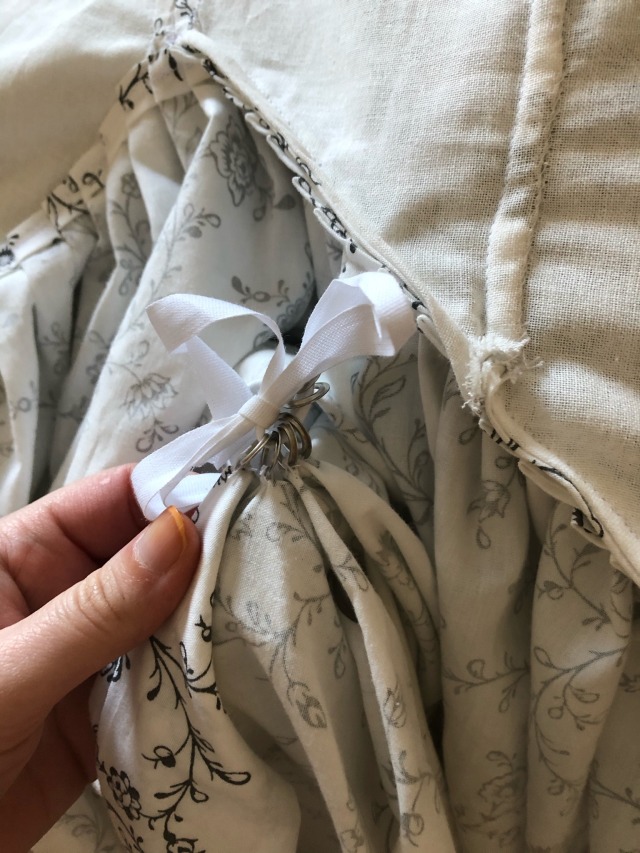

Sorry for my orange nail, it stained from dying my hair red)
Finally, the hooks at the front of the bodice and I was ready to wear it! To be completely honest, yes, it has some flaws but it still felt like I was wearing something straight out of the movies, or another world. I have to use a fichu, not just because it was actually fashionable back then but also because my stays are a little visible at the neckline. I do have another pair of stays, maybe it works better with those, I haven’t tried them yet.
But anyways, here she is - my ca. 1775 (stays are 1750s) Robe à la Polonaise.




The photoshoot I talked about is going to happen at some point in the future. It’s very hot at the moment and I’m barely venturing out in shorts, I’ll have to wait until it’s more bearable to wear all those layers! (Also, I have to build up the courage to go outside in 1770s wear.)
All in all I’d say that this is definitely my favorite thing I’ve ever made. I’m still so in love with that fabric!
Making a Robe à la Polonaise (Part 3)
After being very nervous about starting to make the sleeves to the point where I dreamt that my grandmother told me they were really easy to do and I was stressing out way too much, I finally made the attempt to make a pattern.
Of course, I couldn’t just use one from the internet because I love making things more difficult for myself. Besides, I still had to fit it and I didn’t feel like doing it, so I just looked at the general shape and tried to use my long forgotten high school geometry skills to figure out how to transfer my measurments into an actual drawing, and surprisingly, after some trial and error, it actually worked!

I then proceeded to make a mock-up and pinned it to the bodice to check if fit and after confirming that it did, I could finally cut it out of my actual fabric and lining. I messed up and cut the lining too short (aka I forgot the seam allowance that I’d decided to make 1 inch (2,5cm) which is much bigger than what I usually do so it does make a difference), but I decided that maybe it would be alright if I could somehow fold the bottom edge of the front facing fabric over the raw edge of the lining and conceal it that way. (Spoiler, it worked!)
Anyways, I sewed the lining to the fabric, right sides facing each other and turned it inside out. Then came the pinning to the bodice…


It took a while to get it right, especially the little pleats at the top, but I finally did and attached it to the bodice by sewing very dangerously close to the edge. I don’t think that would’ve been possible with my old 50s sewing machine! With every project I appreciate my new modern version more and more haha.
So then the sleeves were finally attached to the bodice! For a moment I contemplated whether or not I should fell the inside seams on the sleeves as that’s not really something anyone ever gets to see but I finally decided to just do it, to be honest part of the reason I ended up doing it was so I wouldn’t be embarrassed to post my terrible seams on here! To make hand felling easier, I put a water bottle inside of the sleeve. I don’t know if it really does anything as I didn’t even try it without the bottle, but I saw this tip somewhere a while ago so I just thought it might help.

To finally wrap up the day, I finished the bottom sleeve seams by folding the floral fabric over the shorter lining and machine stitched it real quick.
And then, the bodice was complete!




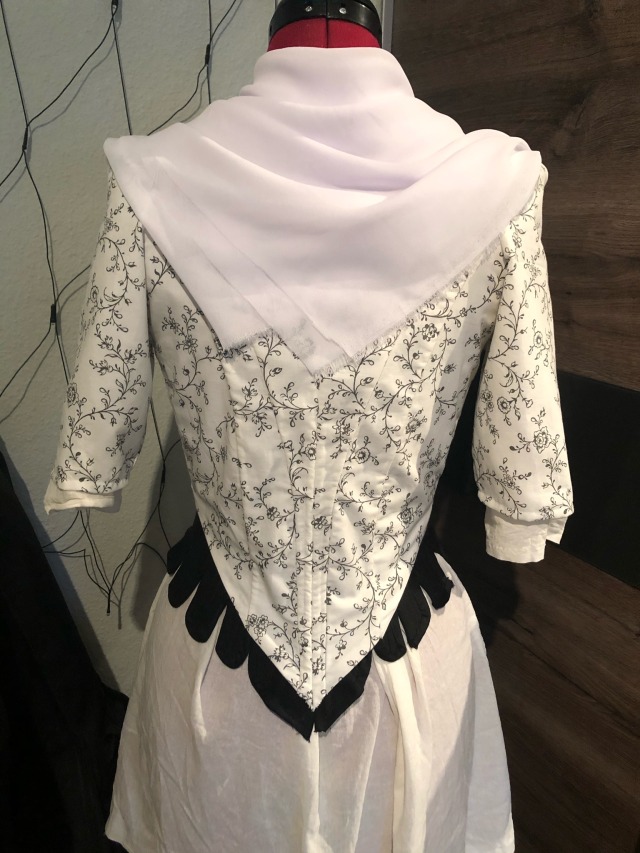
I still have trouble putting it on the mannequin and I might have to change a little bit of the neck line, depending on how it sits on my actual body, but so far I’m very pleased. I’m also super excited because I’m planning on going into the woods and doing a little photoshoot wearing this gown once it’s finished!




